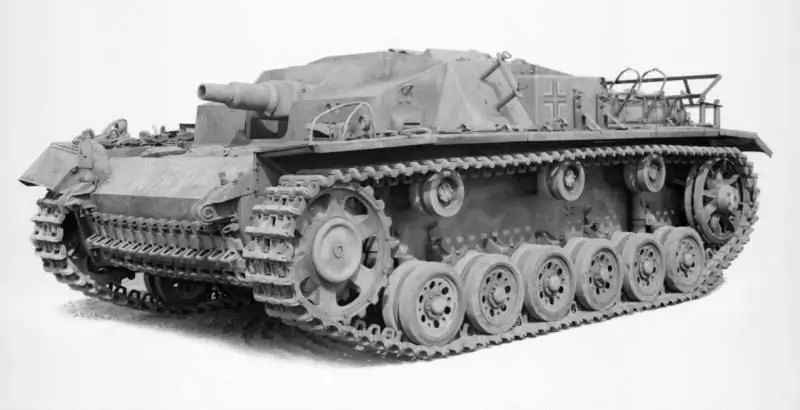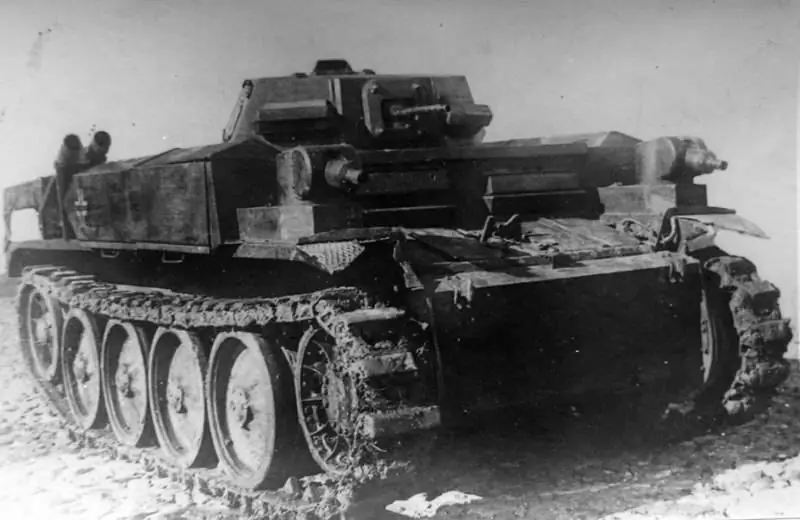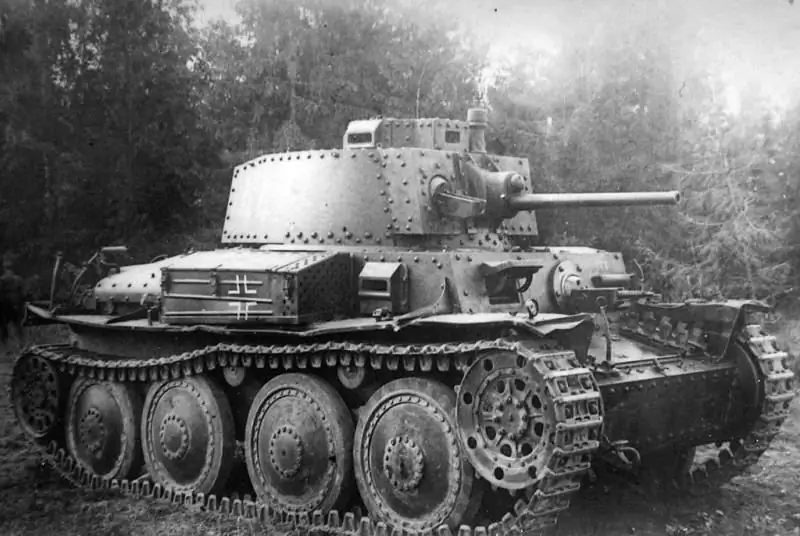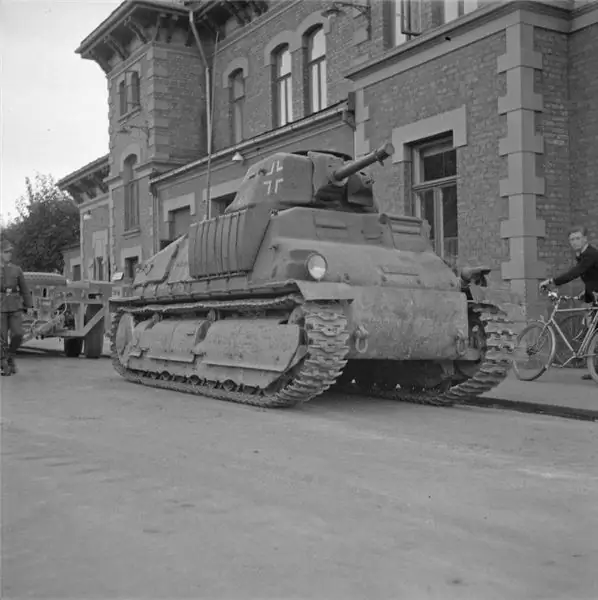- Author Matthew Elmers [email protected].
- Public 2023-12-16 21:49.
- Last modified 2025-01-24 09:17.

Teutonic armor
By the beginning of 1942, the Red Army had accumulated a sufficient amount of captured equipment to organize a full-scale research by scientists and military engineers. Throughout the year, under the guidance of specialists from TsNII-48, the leading institute dealing with armor in the USSR, enemy equipment was thoroughly studied. Firstly, to create guidelines for the fight against fascist tanks, and secondly, to assess the comparative level of development of domestic and enemy metallurgy and engineering. The test participants hoped to pick up new ideas for their own industry during the work.
The objects of research were the most common armored vehicles for their time: T-I, T-IA, T-II tanks, two T-IIIs with a 50-mm KwK 38 cannon and a 37-mm KwK L / 45 cannon. In 1942, the term "self-propelled artillery mount" was not yet generally accepted, so the studied StuG III Ausf. C / D was called "the reckless" Artshturm "medium tank with a 75-mm cannon. Interestingly, the T-IV Ausf. F with a short-barreled 75mm cannon turned out to be a heavy tank according to the Soviet classification! Obviously, TsNII-48 considered that a German tank weighing 24 tons was fully classified as heavy, since the Germans simply did not have a larger armored vehicle at that time. More precisely, the Armored Institute did not know about heavy German tanks, but more about that later.

In the trophy collection of TsNII-48 there was also a rare flamethrower Flammpanzer II Flamingo, which fell into the hands of the Red Army in 1941 near Smolensk. The vehicle fought as part of the 3rd tank group of the 101st flamethrower tank battalion. The flamethrower tank was of an original design, specially adapted for the installation of containers with compressed air and fire mixture. The fire mixture was ignited with acetylene and an electric burner. The pressure in the air cylinders reached 150 atmospheres, which made it possible to throw burning jets from two water cannons at 40-50 meters. The light 12-ton flamethrower tank did not make much of an impression on the Soviet engineers, and they did not find any reason to borrow. The most original was the chassis of the Flammpanzer II Flamingo, about which they wrote:
The chassis of the flamethrower tank in terms of its design is similar to the chassis of the semi-tracked German tractors, but somewhat simplified for production: the pins of the tracks of the auto-half-track tractors rotate on needle bearings, and the tracks have rubber pads, while the fingers of the flamethrower tank are seated tightly on the threads and there are no rubber pads.

Among the studied machines were twice captured Czechoslovak LT vz.35 and LT vz.38, the last of which was called the long "Prague-TNGS-38T" in the reports. The R35 infantry tank and the Somua S35 medium tank represented French equipment that had ended up in the Soviet rear for study by the Armored Institute. The last two tanks received a detailed commentary:
The R35 and Somua S35 are a clear illustration of the French desire to simplify tank production as much as possible and create all the prerequisites for ensuring the mass production of tanks. But widely (wider than all other countries) using armor casting in tank building, they could not achieve its high quality.
Don't wait for thick-armored tanks
At the end of 1942, in the reports of TsNII-48 engineers, there was an almost condescending attitude towards the protection of German tanks. In short, the fascist armor turned out to be thin and unable to withstand domestic 76-mm shells. Good visibility from enemy tanks has been interpreted in an interesting way. A large number of observation devices, it turns out, not only increases the crew's awareness of what is happening around, but also increases the tank's vulnerability to incendiary mixtures and small machine gun fire. Here's a quote that is discouraging:
If we take into account that when firing at viewing devices there is also a significant likelihood of hitting the tank's armament and jamming ball mounts and weapon masks, it becomes obvious that such a seemingly weak anti-tank weapon as small arms and machine gun fire can still be quite effective when used against German tanks, including even medium and heavy ones.
In case, nevertheless, the machine gun against the T-III and T-IV would not have been effective, TsNII-48 suggested using bottles with Molotov cocktails. For this, the German tanks had everything - developed air intakes and an abundance of viewing slots.
The Germans tried to solve the problem of resistance to the T-34 and KV guns by simply shielding the hull with armor plates. The frontal parts of all tanks were necessarily shielded, which, according to TsNII-48, gives out strictly offensive weapons in the vehicles - the sides and stern of the German vehicles remained poorly protected.

Before revealing the main thesis of the first part of the report of the "Armored Institute", it is worth telling who composed this work. Scientific editing was carried out by Doctor of Technical Sciences, Professor Andrei Sergeevich Zavyalov, founder of TsNII-48. The report was based on the work of at least six engineers of the institute. The report was signed by the chief engineer of TsNII-48 Levin E. E. That is, the authors are real professionals in their field and should be well versed in their field. Here is the forecast of engineers regarding the further development of the German armored industry without adjustments:
During the war, one can expect the enemy to have new models of tanks, although the Germans, apparently, in every possible way avoid production complications associated with the transfer of industry to new models and affecting the mass production of weapons. If such new samples appear, then it is unlikely that we will meet in them with the fact of a significant thickening of the armor. Most likely, in accordance with the entire course of development of types of German tanks, one should expect an increase in tank artillery, on the one hand, and an increase in the cross-country ability of tanks in off-road conditions and heavy snow cover, on the other hand.
The report was signed on December 24, 1942, when, we recall, the Soviet troops had already managed to face the newest German "Tiger". The Main Armored Directorate of the Red Army officially learned about the real heavy tanks of the Wehrmacht in early November 1942 from British diplomats. This raises a couple of questions. First, was it possible that TsNII-48 was not aware of the situation at the front and had no connection with the GABTU? And, secondly, why, in response to the "cardboardness" of the Teutonic armor (as they say in the "Armored Institute"), German engineers suddenly have to increase the armament and mobility of tanks? Be that as it may, Soviet tank formations were not qualitatively ready to withstand thick-armored German vehicles until 1944.
Armor chemistry
Screening in the early years of the war for the Germans was the only salvation in front of Soviet artillery and tanks. First of all, the frontal plates, placed closer to the vertical position, were subjected to such protection, and secondly, the upper part of the sides and stern. The Germans used both homogeneous and cemented armor for shielding. And on one of the Czechoslovak LT vz. 38 tanks, engineers immediately discovered a three-layer shielding of 15 mm sheets.
At the same time, according to the testers, the Germans were doing badly with the fastening of the armored screens - the steel sheets were torn off the hull after one or two hits. In general, at the time of the report, TsNII-48 was skeptical about the shielding of tanks, assuring that it was easier and more profitable to simply weld on additional armor without leaving an "air gap". At the same time, since 1941, the Armored Institute has been working on shielding the T-34 armor. At the Krasnoye Sormovo plant, some of the tanks were even produced with similar armor.
The real interest of the testers was aroused by the "Artshturm" self-propelled gun or the StuG III Ausf. C / D, which turned out to be a relatively simple machine to manufacture, and even equipped with a powerful weapon. On the battlefield, such a "reckless tank" with the proper level of mobility lost a little in tactical terms in comparison with a classic tank.

Now about German tank chemistry. As expected, the main alloying element was chromium, which enemy steelmakers added to the armor in the range of 1-2, 5%. The next in importance was molybdenum (0.2-0.6%), followed by silicon and nickel (1-2%). Manganese, widely used as an alloying additive in Soviet armor, did not find much distribution in captured steel. Only in chromium-molybdenum armor with a low content of chromium, vanadium and molybdenum could a relatively high proportion of manganese be noted - up to 0.8%. The Germans added manganese to such a steel recipe only for the desire to ensure the hardenability of armor to a thickness of 20-40 mm with a simultaneous low content of chromium and molybdenum. Among the reasons for saving manganese was the chronic shortage of this metal in Germany, as well as the desire to avoid cracking on tank hulls during welding.
Metallurgists of TsNII-48 also noted a high carbon content in German armor - up to 0.5%. In Soviet tank armor, the proportion of this element varied from 0.27% to 0.35%. What did carbon affect? First of all, the hardness of steel - in German cars it was much higher than that of the T-34, and even more so than that of the KV. At the same time, a high carbon content significantly increases the likelihood of cracking during welding, but the Germans surprisingly managed to avoid this (including due to the small fraction of manganese). But domestic thirty-fours could not get rid of dangerous cracks on the case for a very long time.
The end follows …






